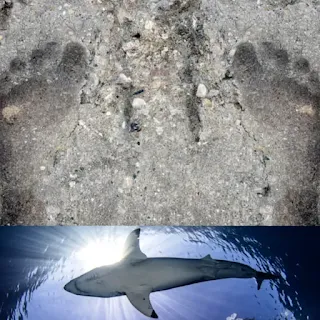Two tracks of ancient human footprints etched on a beach in Morocco form one of the largest and best-preserved tracks in the world.
Scientists found the site of the footprints near the northern tip of North Africa in 2022 while studying rocks on the shore of a small bay in the city of Larache, according to a study published on January 23 in the journal Scientific Reports.
“Between the tides, I told my team that we should head north to explore another beach,” Moncef Essedrati, lead author of the study and associate professor of coastal dynamics and geomorphology at the University of Southern Brittany in France, told Live Science. “We were surprised to find the first trace.” "At first, we were not convinced that it was a footprint, but then we found more traces."
Analysis of the site, the only known human track site of its kind in North Africa and the southern Mediterranean, revealed two tracks containing a total of 85 human footprints imprinted on the beach by a group of at least five early modern humans.
The team used optically stimulated luminescence dating, a technique that determines when certain metals found on or near an artifact were last exposed to heat or sunlight.
The real "Star Wars" meteorite in Tunisia reveals the secrets of our early solar system
Based on the age of the fine quartz grains that make up the bulk of the steep beach sand, scientists suggest that a multi-generational group of Homo sapiens walked the beach about 90,000 years ago, creating the tracks.
This event occurred during the late Pleistocene era, also known as the last ice age, which ended about 11,700 years ago, according to the study.
“We conducted on-site measurements to determine the length and depth of the printed monuments,” Al-Sedrati said. He added, "Based on foot pressure and the size of the footprints, we were able to determine the approximate age of the individuals, which includes children, teenagers, and adults."
Scientists attribute the excellent preservation of the ancient ruins to a number of factors, including beach layout and long tidal ranges for "ultimate preservation of the footprints," according to the study.
"The exceptional thing is the location of the beach on a rocky platform covered with clay deposits. These deposits create good conditions for maintaining tracks on the sandbar while the tides quickly bury the beach. That is why the footprints are well preserved here," explained Al-Sidrati.
However, scientists are still unsure about what the Ice Age group was doing on the beach, and future analysis of the site could reveal this information. But they will have to act quickly, because "continuous collapse of the rocky beach platform could lead to its eventual demise," including the remains preserved on it, the team behind the study wrote.
“We hope to learn about the overall history of this group of people and what they were doing there,” Al-Sedrati said.
The first sighting of a newborn white shark has sent scientists crazy
A wildlife filmmaker and biology student has recorded an event that scientists have been searching for for a long time: the first-ever glimpse of a newborn great white shark.
The baby shark was seen hundreds of meters off the coast of Santa Barbara, California, in July last year, in footage by director Carlos Gaona.
White sharks (Carcharodon carcharias) are usually gray above with a bright white belly. Pregnant females produce “uterine milk,” a yellowish milky fluid that is consumed by the fetuses.
Gaona saw several apparently pregnant sharks in the same area. So the bright white shark immediately stood out to him when it surfaced.
“On this day, one of them dived, and soon after, this whole white shark appeared,” says Gaona, who uses the online site The Malibu Artist. “It's not a stretch to conclude where it came from.”
The sighting of a newborn white shark has not yet been confirmed, although Gaona and co-author Philip Stearns, a shark biologist at the University of California Riverside, published the results in a peer-reviewed journal.
Furthermore, this discovery adds to previous 2020 reports of the smallest known white shark, measuring just 1 meter long and believed to be a newborn, which was caught off the Pacific coast near the US-Mexico border.
Observations by emerging natural scientists or citizen scientists often find their place in the scientific literature. In fact, lucky observations are an important part of scientific exploration and discovery that expands our understanding of the world.
However, there are other possible explanations that we should consider, as the shark could have an unknown skin disorder that causes its skin to fall off, or be covered in some white microbial growth. It may also be a rare case of albinism.
The results were published in Fish Environmental Biology.


Informative
ReplyDelete